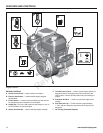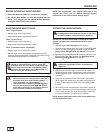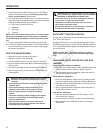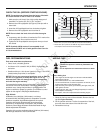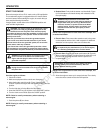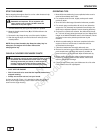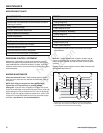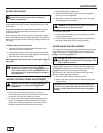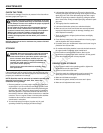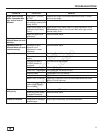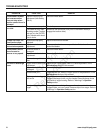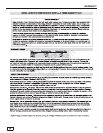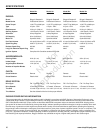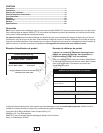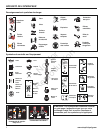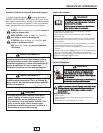
MAINTENANCE
22 www.simplicitymfg.com
CHECK THE TIRES
Check tires for damage. Check the air pressure in the tires with an
accurate gauge (see Figure 17).
CAUTION: Avoid Injury! Explosive separation of tire and
rim parts is possible when they are serviced incorrectly.
• Do not attempt to mount a tire without the proper equipment
and experience to perform the job.
• Do not inflate the tires above the recommended pressure.
• Do not weld or heat a wheel and tire assembly. Heat can
cause an increase in air pressure resulting in an explosion.
Welding can structurally weaken or deform the wheel.
• Do not stand in front or over the tire assembly when
inflating. Use appropriate tool that allows you to stand to
one side.
NOTICE: Check side of tire for maximum tire pressure. DO NOT
exceed maximum.
3. Lubricate the piston/cylinder area. This can be done by first
removing the spark plug and squirting clean engine oil into the
spark plug hole. Then cover the spark plug hole with a rag to
absorb oil spray. Next, rotate the engine by pulling the starter
two or three times. Finally, reinstall spark plug and attach spark
plug wire.
4. Thoroughly clean the snowthrower.
5. Lubricate all lubrication points (see authorized dealer).
6. Make sure all nuts, bolts, and screws are securely fastened.
Inspect all visible moving parts for damage, breakage, and
wear. Replace if necessary.
7. Touch up all rusted or chipped paint surfaces; sand lightly
before painting.
8. Cover the bare metal parts of the snowthrower housing auger,
and the impeller with rust preventative.
9. If possible, store your snowthrower indoors and cover it to give
protection from dust and dirt.
10. On models with folding handles, loosen the knobs that secure
the upper handle. Rotate the upper handle back.
11. If the machine must be stored outdoors, block up the
snowthrower and ensure the entire machine is off the ground.
Cover the snowthrower with a heavy tarpaulin.
STORAGE
WARNING: Never store the engine, with fuel in the tank,
indoors or in a poor ventilated enclosure where fuel
fumes could reach an open flame, spark or pilot light
as on a furnace, water heater, clothes dryer, etc.
Handle gasoline carefully. It is highly flammable and
careless use could result in serious fire damage to
your person and/or property.
Drain fuel into approved containers outdoors, away
from open flame.
If the snowthrower will be stored for thirty (30) days or more at the
end of the snow season, the following steps are recommended to
prepare your snowthrower for storage.
NOTE: Gasoline must be removed or treated to prevent gum
deposits from forming in the tank, filter, hose, and
carburetor during storage.
1. Remove gasoline, by running engine until tank is empty and
engine stops. If you do not want to remove the gasoline, add
fuel stabilizer to any gasoline left in the tank to minimize gum
deposits and acids. If the tank is almost empty, mix stabilizer
with fresh gasoline in a separate container and add some of
the mixture to the tank. Always follow instructions on stabilizer
container. Then run engine at least 10 minutes after stabilizer
is added to allow mixture to reach carburetor. Store
snowthrower in safe place.
2. You can help keep your engine (4-cycles only) in good
operating condition by changing oil before storage.
REMOVE FROM STORAGE
1. Put the upper handle in the operating position, tighten the
knobs that secure the upper handle.
2. Fill the fuel tank with a fresh fuel.
3. Check the spark plug. Make sure the gap is correct. If the
spark plug is worn or damaged, replace before using.
4. Make sure all fasteners are tight.
5. Make sure all guards, shields, and covers are in place.
6. Make sure all adjustments are correct.
Not for
Reproduction



